Magnetic Fields
 We will now deal with
objects which are very commonly used in practical engineering fields.Although
they are too much of idealization ,yet they are so important to know that
the entire study of electrodynamics is incomplete without them.I expect
Rohina and Rahul that you went through the reference for Gauss law I gave
you. I will like you to take a brief review of Gauss law and Ampere's Law
before we proceed any further.To begin lets consider a simple case of a
wire of infinite length .
We will now deal with
objects which are very commonly used in practical engineering fields.Although
they are too much of idealization ,yet they are so important to know that
the entire study of electrodynamics is incomplete without them.I expect
Rohina and Rahul that you went through the reference for Gauss law I gave
you. I will like you to take a brief review of Gauss law and Ampere's Law
before we proceed any further.To begin lets consider a simple case of a
wire of infinite length .
 Sir,are we going to discuss the field pattern around it?
Sir,are we going to discuss the field pattern around it?
 Yes.By the BiotSavart law we can get the field at each point , but by clever
deductions from the elements of symmetry we can predict the magnetic lines
of force at a glance.In this case the magnetic fields have to be tangential
and the magnitude has to be constant for same r(the modulus of r as in cylindrical
coordinate system)
Yes.By the BiotSavart law we can get the field at each point , but by clever
deductions from the elements of symmetry we can predict the magnetic lines
of force at a glance.In this case the magnetic fields have to be tangential
and the magnitude has to be constant for same r(the modulus of r as in cylindrical
coordinate system)
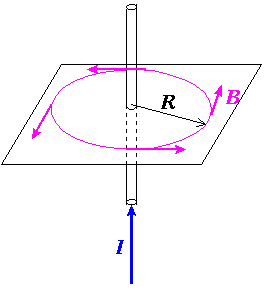
Now my question is how will one predict the direction of magnetic lines of force around the wire ?
 (almost
interrupting ) I know it ,Sir, its the right hand rule.
(almost
interrupting ) I know it ,Sir, its the right hand rule.
 That's good ! Rahul.The diagram here would further enhance your grasp
That's good ! Rahul.The diagram here would further enhance your grasp

 What is the next
geometry we are going to talk about ?
What is the next
geometry we are going to talk about ?
 We are now going to consider the magnetic field due to a current carrying
loop.
We are now going to consider the magnetic field due to a current carrying
loop.
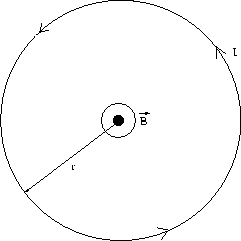
First let's consider the field at a point on the axis itself.The application of the Biot-Savart law on the centerline of a current loop involves integrating the z-component. The symmetry is such that all the terms in this element are constant except the tangential component, which when integrated just gives the circumference of the circle. The magnetic field is then B = k *I/r where k = constant.For other points other than centre of loop you will have to integrate after taking appropriate components into account.
 Sir,why
not a general point ?
Sir,why
not a general point ?
 The
general case is more mathematical in nature and can be worked by Biot Savart
Law.Let's talk about the direction of field in the previous case.The field
at a point on the axis is parallel to axis itself.The direction may be obtained
as follows.Curl the fingers of your right hand in the direction of flow of
current The direction in which thumb points gives you the direction of magnetic
field at that point. I hope the diagram will help you better.
The
general case is more mathematical in nature and can be worked by Biot Savart
Law.Let's talk about the direction of field in the previous case.The field
at a point on the axis is parallel to axis itself.The direction may be obtained
as follows.Curl the fingers of your right hand in the direction of flow of
current The direction in which thumb points gives you the direction of magnetic
field at that point. I hope the diagram will help you better.
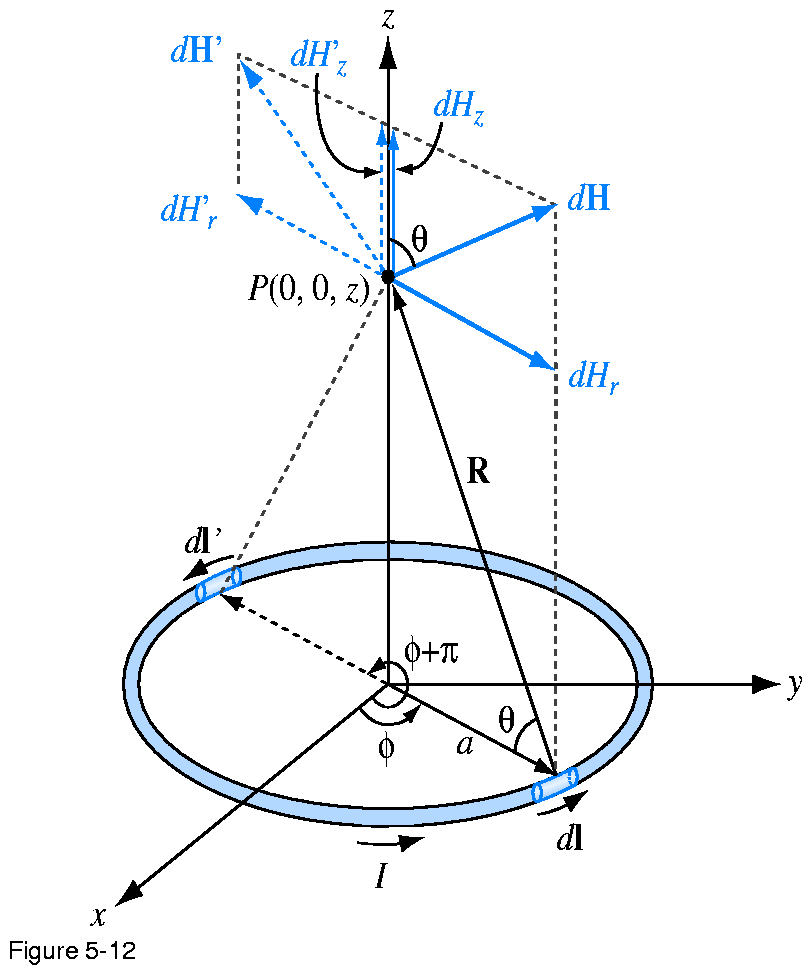
 Next
we will deal with Solenoid.
Next
we will deal with Solenoid.
 What is a solenoid ,Sir.
What is a solenoid ,Sir.
 A solenoid is a coil of wire designed to create a strong magnetic field
inside the coil.By wrapping the same wire many times around the cylinder,
the
magnetic field due to the wires can become quite strong .In some cases we
idealize the solenoid to be infinitely large thus making calculations easier.
A solenoid is a coil of wire designed to create a strong magnetic field
inside the coil.By wrapping the same wire many times around the cylinder,
the
magnetic field due to the wires can become quite strong .In some cases we
idealize the solenoid to be infinitely large thus making calculations easier.
 But
do we consider the solenoid as a number of rings placed close to each other
But
do we consider the solenoid as a number of rings placed close to each other
 Yes
,and thus we use the formulae derived for a single ring invoking the principle
of superposition.The formula for field inside a solenoid is
Yes
,and thus we use the formulae derived for a single ring invoking the principle
of superposition.The formula for field inside a solenoid is
. The number of turns N refers to the number of loops the solenoid has. More loops will bring about a stronger magnetic field. The formula for the field inside the solenoid is
B = m0 I N / L
This formula can be accepted on faith; or it can be derived
using Ampere's law as follows. Look at a cross section of the solenoid.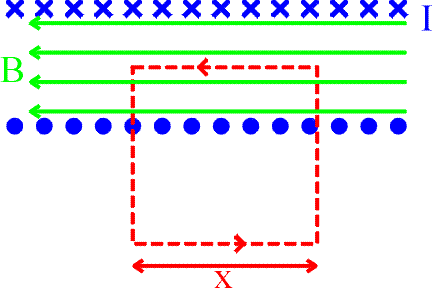
The blue crosses represent the current traveling into the page, while the blue dots represent the currents coming out of the page. Ampere's law (left) for the red path can be written as B = k*I where k is mu divided by 2 pi.
where the number of loops enclosed by the path is (N/L)x. Only the upper portion of the path contributed to the sum because the magnetic field is zero outside, and because the vertical paths are perpendicular to the magnetic field. By dividing x out of both sides of the last equation, one finds:
The magnetic field inside a solenoid is proportional to both the applied current and the number of turns per unit length. There is no dependence on the diameter of the solenoid, and the field strength doesn't depend on the position inside the solenoid, i.e., the field inside is constant.
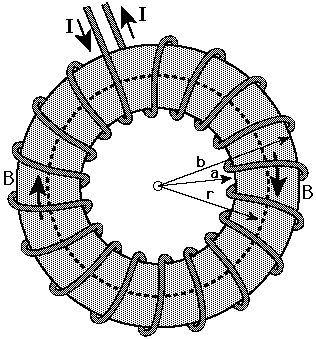
 Now
let me discuss about toroid which is shown above.Finding the magnetic field
inside a toroid is a good example of the power of Ampere's law. The current
enclosed by the dashed line is just the number of loops times the current
in each loop. Amperes law then gives the magnetic field by
Now
let me discuss about toroid which is shown above.Finding the magnetic field
inside a toroid is a good example of the power of Ampere's law. The current
enclosed by the dashed line is just the number of loops times the current
in each loop. Amperes law then gives the magnetic field by
